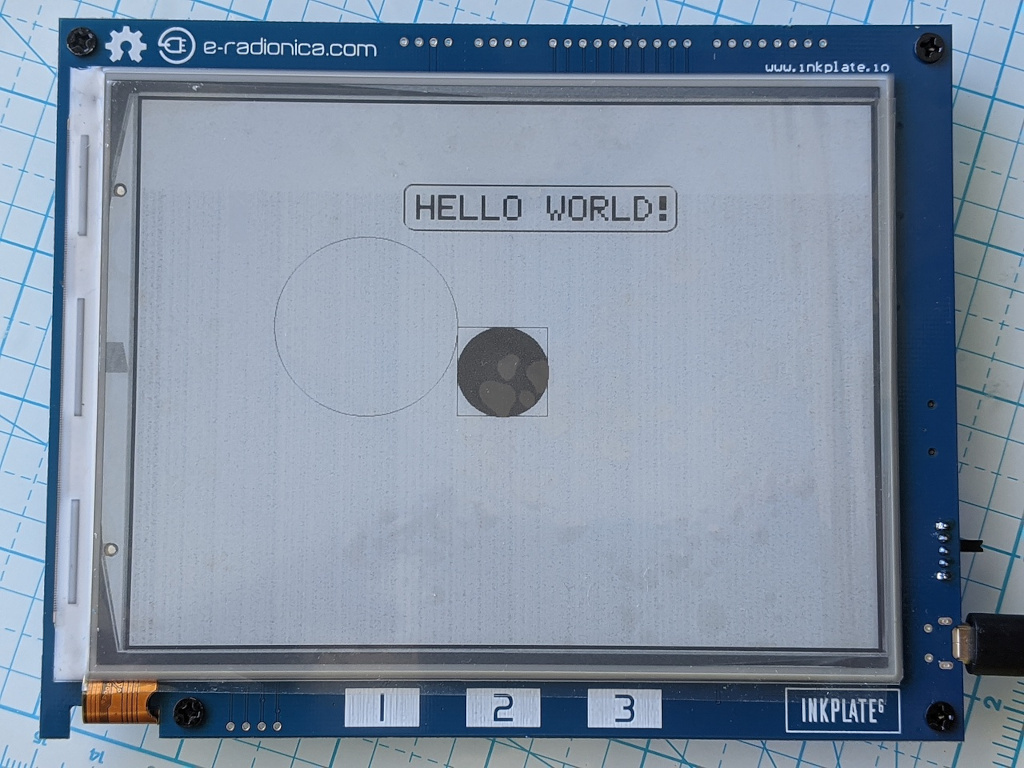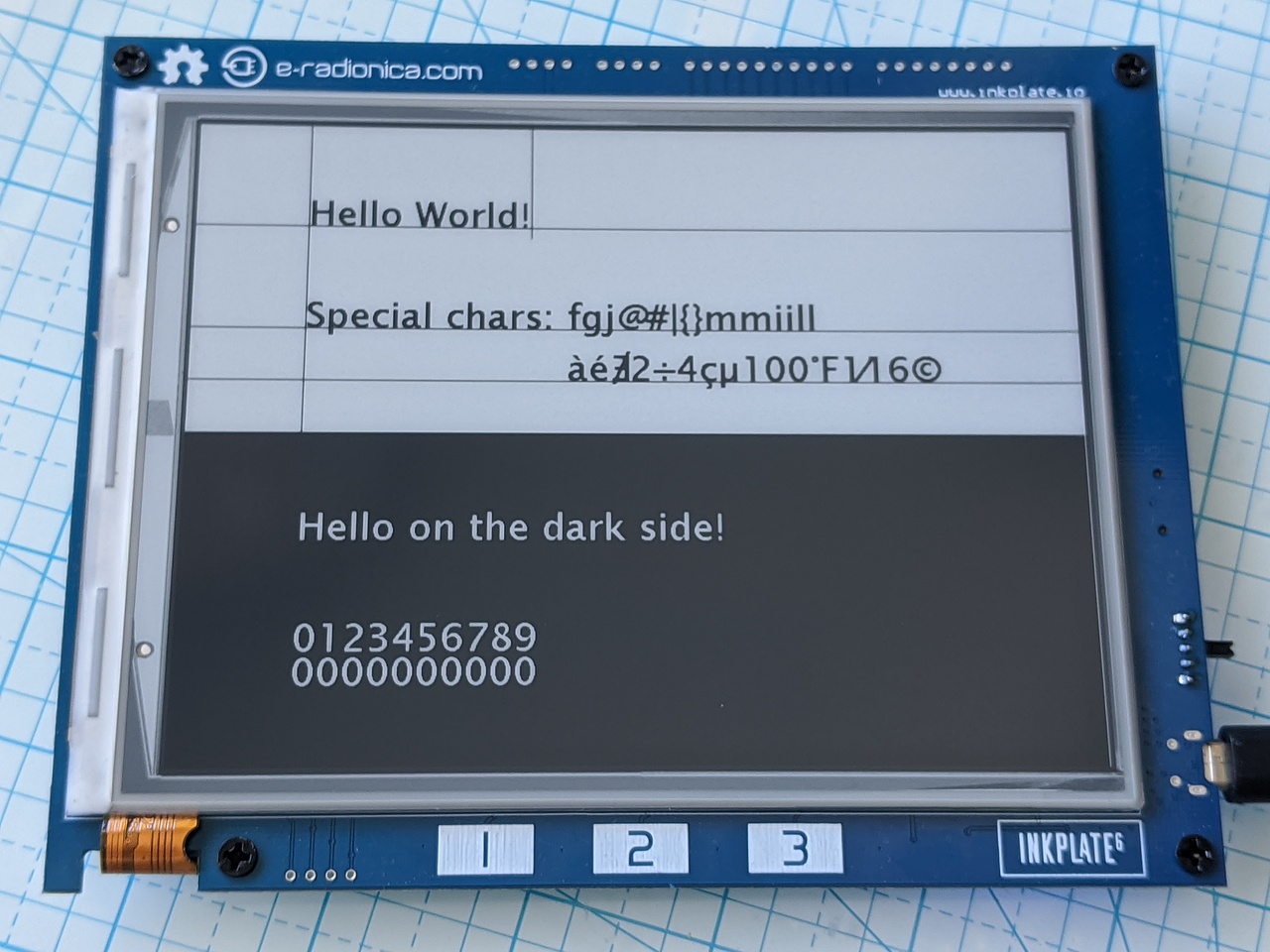Awesome
Inkplate 6 & Inkplate 10
This repository contains MicroPython drivers for the E-Radionica Inkplates 6 and 10: an ESP32 board with a 6", respectively 10", E-paper display and three capacitive touch buttons/sensors.
Inkplate info
- CrowdSupply projects: https://www.crowdsupply.com/e-radionica/inkplate-6 and https://www.crowdsupply.com/e-radionica/inkplate-10
- Hardware: https://github.com/e-radionicacom/Inkplate-6-hardware and https://github.com/e-radionicacom/Inkplate-10-hardware
- Forum: http://forum.e-radionica.com/en/viewtopic.php?f=25&t=260
Features
- Simple graphics class (similar to Adafruit GFX) for monochrome and 2-bit greyscale use of the ePaper display.
- Simple graphics class for 2 bits per pixel greyscale use of the ePaper display.
- Support for partial updates (currently only on the monochrome display).
- Support for ("u8g2" fonts)[https://github.com/olikraus/u8g2] including rendering from the compressed format.
- Access to touch sensors.
- Everything in pure python with screen updates virtually as fast as the Arduino C driver.
Getting started
-
Flash MicroPython v1.12
GENERIC_SPIRAMor more recent to your inkplate, e.g.esp32spiram-idf4-20191220-v1.12.binfrom http://micropython.org/download/esp32/ (it's the very last download link on that page). -
Copy library files to your board, something like:
pyboard.py --device /dev/ttyUSB0 -f cp mcp23017.py shapes.py u8g2_font.py luRS24_te.u8f :(You can find
pyboard.pyin the MicroPython tools directory or just download it from GitHub: https://raw.githubusercontent.com/micropython/micropython/master/tools/pyboard.py) -
For the Inkplate 10 change the comments for
D_ROWSandD_COLSaround on lines 31-36 ofinkplate.py. -
Run
inkplate.py:pyboard.py --device /dev/ttyUSB0 inkplate.py -
On the terminal console you should see a bunch of progress lines:
Mono: clean 857ms (17ms ea), draw 298ms (49ms ea), total 1155ms GS2: clean 855ms (17ms ea), draw 696ms (99ms ea), total 1551ms GFXPatt: in 102ms Mono: clean 858ms (17ms ea), draw 297ms (49ms ea), total 1155ms GFX: in 36ms Partial: draw 166ms (33ms/frame 65us/row) (y=90..158) ... -
On the display you should see it clearing, then showing a monochrome test pattern, clearing and showing a greyscale test pattern, then clearing and showing the following test pattern:

-
The "Hello World" box should then move across the display using partial updates. Here's a video of what that looks like (this is actual speed):

Sorry for the hand-held shaking... It does look better in real-life when not quantized down to fit into github!
-
After a brief pause you will see the first test pattern again. Touch the touchpad "3" to advance to the next test pattern.
-
Look at the end of
inkplate.pyto see the demo code. -
An initial version of "u8g2" font support can be found in
u8g2_font.py. The rendering is currently not optimized due to a bug in MicroPython's viper code emitter (oops!) but the performance seems reasonable. To try it out copyinkplate.pyto flash:pyboard.py --device /dev/ttyUSB0 -f cp inkplate.py :Then run the demo:
pyboard.py --device /dev/ttyUSB0 u8g2_font.pyAnd have some patience until everything loads and draws incrementally until you see:

-
Additional fonts can be downloaded as C files from https://github.com/olikraus/u8g2/tree/master/tools/font/build/single_font_files (realistically you will need to grab the repo...), see (that repo's wiki)[https://github.com/olikraus/u8g2/wiki/fntgrp] for an index to all the fonts available. Once you grabbed a C file for the font, run
./u8g2_convert.py <u8g2_font_blah.cand upload the resulting.u8fbinary font file. -
(This is superceded by the u8g2 font support.) An initial version of BDF font support can be found in
bdf_font.py. The BDF font parsing is super-slow and needs a better solution, but the text looks good. To try it out copy the provided font to flash, warning it takes the better part of a minute to upload the font file!pyboard.py --device /dev/ttyUSB0 -f cp luRS24.bdf :Then run the demo:
pyboard.py --device /dev/ttyUSB0 bdf_font.pyAnd have some patience until everything loads and draws incrementally.
Info
Partial Updates
The partial update works as follows. An InkplateMono is allocated as well as an InkplatePartial
based on it. Then an initial image is drawn using InkplateMono and InkplatePartial.start() is
called, which makes a copy of the image from InkplateMono. The desired screen changes are drawn
normally on the InkplateMono and when they're ready to display, InkplatePartial.display() is
called.
What InkplatePartial.display does is to render the attached InkplateMono but as it renders it
compares the pixels with those saved by the call to start(). For pixels that have not changed
it sends a "no change" code to the display and for ones that have changed it sends the appropriate
waveform. Sending "no change" is faster than sending the waveform and the partial update waveform
is shorter (thus faster) than the standard refresh-the-screen waveform.
In addition, a bounding box can be passed to InkplatePartial.display and it will skip rows outside
of the bounding box, which is faster than sending a full rows of "no change". (The x/width
parameters to InkplatePartial.display are currently unused and cannot be used to exclude the
update of pixels that were changed but shouldn't be displayed.)
Greyscale
Greyscale display is supported using InkplateGS2 providing 2 bits per pixel.
2-bit greyscale was chosen because it nicely packs 4 pixels into a byte, doesn't use a ton of
memory, and is still fast. Using 3-bit greyscale is not supported by the MicroPython framebuf
module, and doesn't pack nicely into bytes. 4-bit greyscale uses a lot of memory and becomes
rather slow, plus it's not clear decent open source ePaper waveforms can be worked out to
actually display that many levels.
It seems that the main use for more than 2-bit greyscale is the display of images. The results of the Arduino C driver displaying images quantized to 8 levels (3 bits per pixel) look rather unconvincing (IMHO) with large flat blotches where the original images has a gradient (for example portions showing the sky). It seems that images dithered to 2-bit greyscale with Floyd-Steinberg or equivalent ought to look better than that.
All this being said, it shouldn't be all that much work to make a clone of InkplateGS2 that
supports 4-bit greyscale.
Performance and Timing
The update speed relies heavily on the MicroPython viper compile-to-native functionality. It's great because it allows a pure python library. But it also sucks because it's not really that good and the code starts to become pretty obscure. It would be smart to recode the key functions in C and provide an optional pre-compiled mpy file with that. This is probably only worth doing once all the kinks are worked out and the intricacies of the ePaper displaya are better understood.
The timing of the display update is based on "it seems to work". It appears that the rate at which rows are updated is really faster than spec. This can have some very unintuitive side-effects. For example, if the speed at which rows are skipped is increased in the partial update, the rows that are subsequently updated are washed out (even if they are written as slowly as before)! It would be good to exert more care with the update speed in the future C primitives.
Display background info
- Display Datasheet: http://www.universaldisplay.asia/wp-content/uploads/2012/10/ED060SC7-2.0.pdf
- Essential Scrap page: http://essentialscrap.com/eink/waveforms.html
- SpriteTM page: http://spritesmods.com/?art=einkdisplay&page=1
- General background on waveforms: https://wenku.baidu.com/view/00bbfb6727d3240c8447efd5.html
- Display flash chip: MX25L2006 2Mbit (256KBytes)
ESP32 GPIO map
| GPIO | Std func | Inkplate | Description |
|---|---|---|---|
| 0 | pup/ftdi | EPD-CL | Clock byte, positive pulse |
| 1 | U0TXD | TX | |
| 2 | pdn | EPD-LE | Latch (row) enable: positive pulse |
| 3 | U0RXD | RX | |
| 4 | EPD-D0 | ||
| 5 | pup | EPD-D1 | |
| 12 | pdn, mmiso | SPI-MISO | |
| 13 | msck | SPI-MOSI | |
| 14 | SPI-CK | ||
| 15 | mmosi | SPI-CS | |
| 16 | PSRAM | ||
| 17 | PSRAM | ||
| 18 | vsck | EPD-D2 | |
| 19 | vmosi | EPD-D3 | |
| 21 | SDA | ||
| 22 | SCL | ||
| 23 | vmiso | EPD-D4 | |
| 25 | dac1 | EPD-D5 | |
| 26 | dac2 | EPD-D6 | |
| 27 | EPD-D7 | ||
| 32 | adc4 | EPD-CKV | Clock vertical: positive pulse |
| 33 | adc9 | EPD-SPH | Start pulse horizontal, active low |
| 34 | in, adc6 | INTB | interrupt from MCP23017 |
| 35 | in, adc7 | BATV | |
| 36 | in, adc0 | ||
| 39 | in, adc3 |
I2C I/O Expander MCP23017
| IO | Function | Description |
|---|---|---|
| A0 | EPD-OE | |
| A1 | EPD-GMODE | Gate output mode: high to enable |
| A2 | EPD-SPV | Start pulse vertical, active low |
| A3 | TPS65186 WAKEUP | |
| A4 | TPS65186 PWRUP | |
| A5 | TPS65186 VCOM-CTRL | |
| A6 | TPS65186 INT | |
| A7 | TPS65186 PWR-GOOD | |
| B0 | GPIO0-MOSFET (EPD-CL) | low pulls gpio0/EPD-CL high via 1K Ohm |
| B1 | VBAT-MOSFET | low enables VBAT |
| B2 | TOUCH1 | |
| B3 | TOUCH2 | |
| B4 | TOUCH3 | |
| B5 | K19 | |
| B6 | K20 | |
| B7 | K21 |